University of Western Sydney: Epidemiology Assignment 2 Analysis
VerifiedAdded on 2020/04/07
|8
|2182
|50
Homework Assignment
AI Summary
This assignment solution addresses key concepts in epidemiology, using a provided research paper on the long-term effects of physical activity on coronary heart disease (CHD) to illustrate study design, including a longitudinal study. The assignment analyzes the study's methodology, justifications, and findings, such as the proportion of participants engaged in physical activity and the crude incidence rates. It also explores the relative risk of CHD based on activity levels, and the interpretation of sex and age-adjusted relative risks. Furthermore, the assignment examines potential biases, confounders, and the impact of self-rated health on the study's outcomes. Additional questions delve into a case study on the association between a drug (Reserpine) and breast cancer, calculating and interpreting measures of association. The assignment also covers a case-control study on diabetes and sleep-disordered breathing, addressing potential biases and methods to mitigate them, and concludes with questions on selection and measurement biases in research.
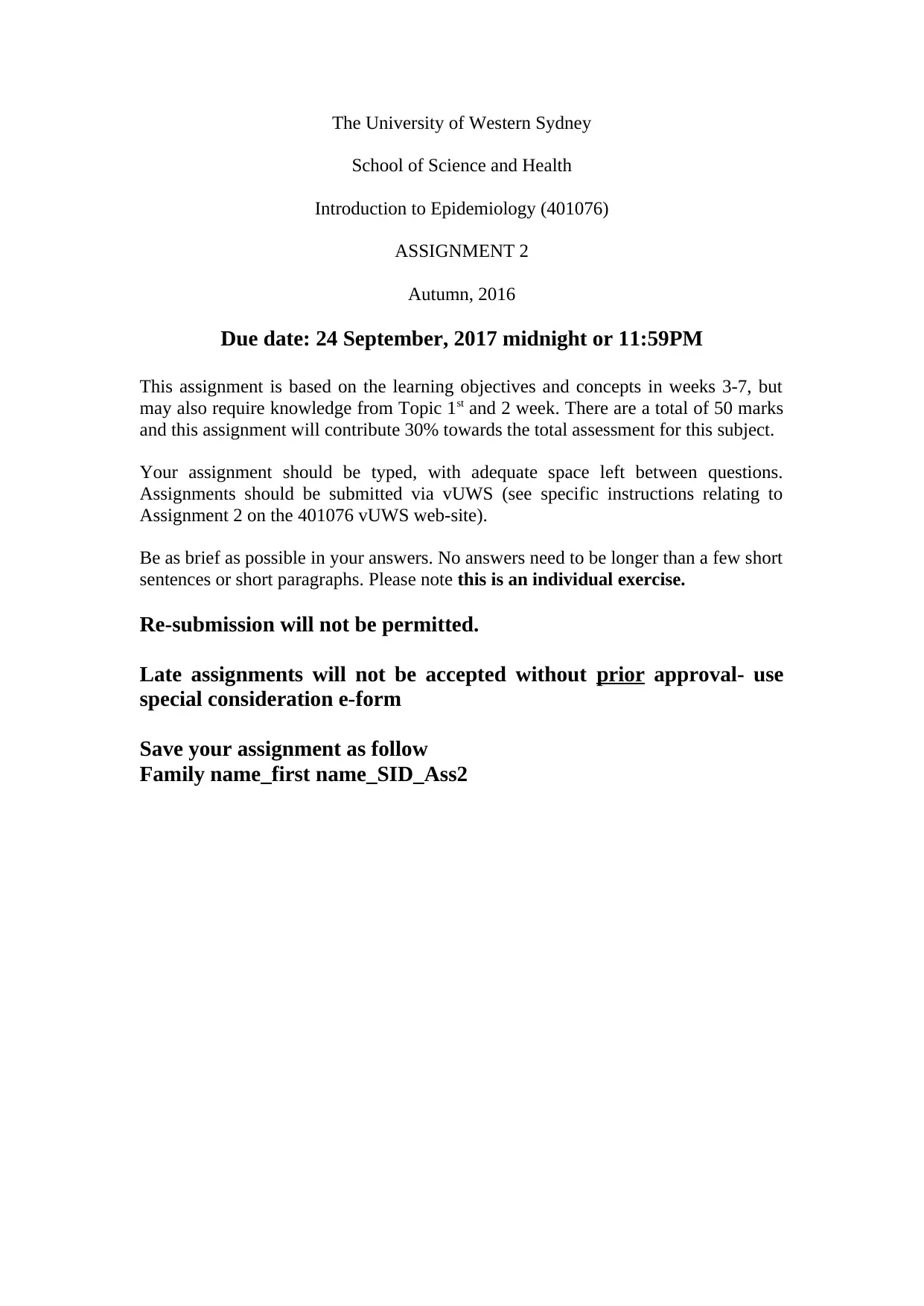
The University of Western Sydney
School of Science and Health
Introduction to Epidemiology (401076)
ASSIGNMENT 2
Autumn, 2016
Due date: 24 September, 2017 midnight or 11:59PM
This assignment is based on the learning objectives and concepts in weeks 3-7, but
may also require knowledge from Topic 1st and 2 week. There are a total of 50 marks
and this assignment will contribute 30% towards the total assessment for this subject.
Your assignment should be typed, with adequate space left between questions.
Assignments should be submitted via vUWS (see specific instructions relating to
Assignment 2 on the 401076 vUWS web-site).
Be as brief as possible in your answers. No answers need to be longer than a few short
sentences or short paragraphs. Please note this is an individual exercise.
Re-submission will not be permitted.
Late assignments will not be accepted without prior approval- use
special consideration e-form
Save your assignment as follow
Family name_first name_SID_Ass2
School of Science and Health
Introduction to Epidemiology (401076)
ASSIGNMENT 2
Autumn, 2016
Due date: 24 September, 2017 midnight or 11:59PM
This assignment is based on the learning objectives and concepts in weeks 3-7, but
may also require knowledge from Topic 1st and 2 week. There are a total of 50 marks
and this assignment will contribute 30% towards the total assessment for this subject.
Your assignment should be typed, with adequate space left between questions.
Assignments should be submitted via vUWS (see specific instructions relating to
Assignment 2 on the 401076 vUWS web-site).
Be as brief as possible in your answers. No answers need to be longer than a few short
sentences or short paragraphs. Please note this is an individual exercise.
Re-submission will not be permitted.
Late assignments will not be accepted without prior approval- use
special consideration e-form
Save your assignment as follow
Family name_first name_SID_Ass2
Paraphrase This Document
Need a fresh take? Get an instant paraphrase of this document with our AI Paraphraser
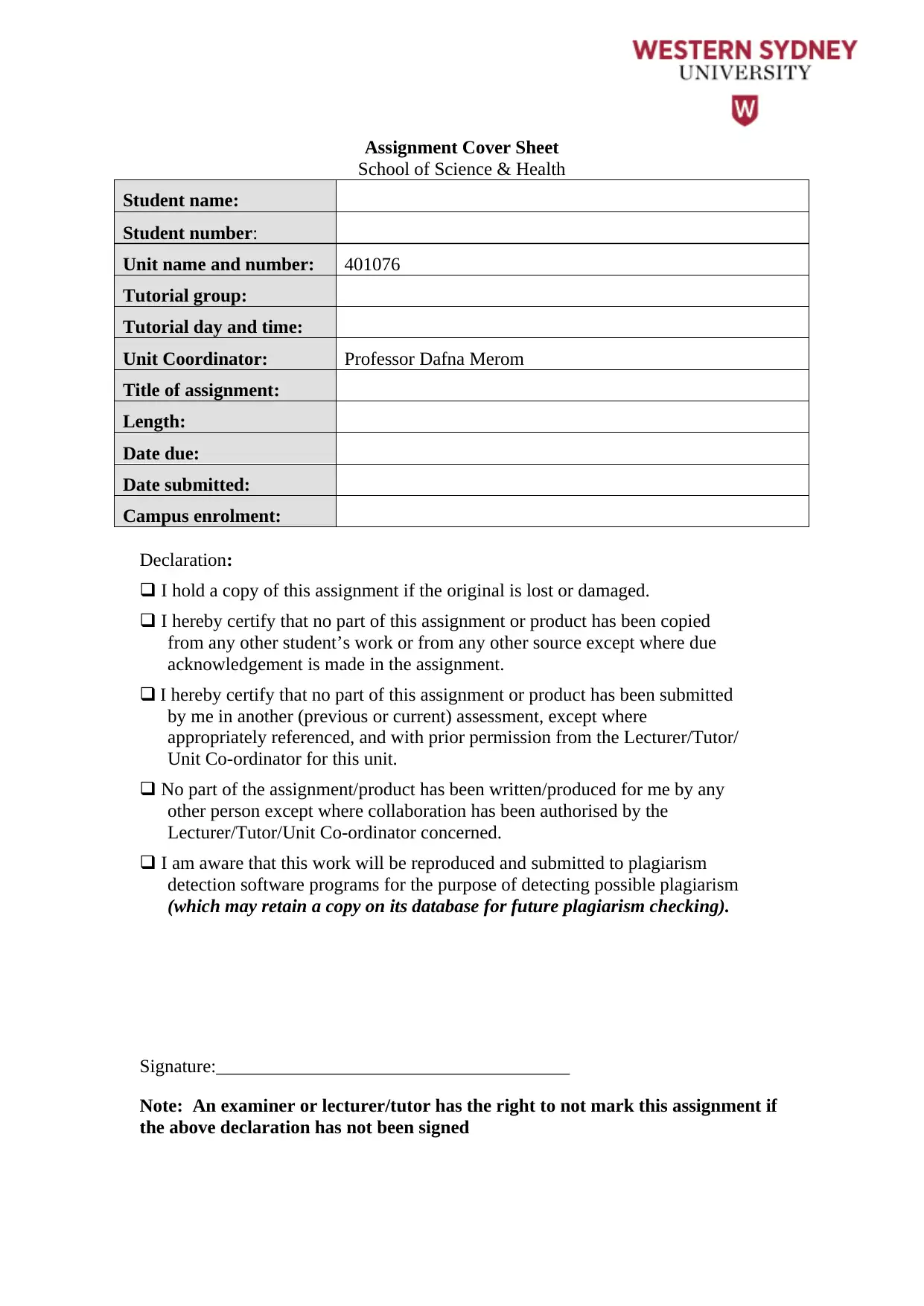
Assignment Cover Sheet
School of Science & Health
Student name:
Student number:
Unit name and number: 401076
Tutorial group:
Tutorial day and time:
Unit Coordinator: Professor Dafna Merom
Title of assignment:
Length:
Date due:
Date submitted:
Campus enrolment:
Declaration:
I hold a copy of this assignment if the original is lost or damaged.
I hereby certify that no part of this assignment or product has been copied
from any other student’s work or from any other source except where due
acknowledgement is made in the assignment.
I hereby certify that no part of this assignment or product has been submitted
by me in another (previous or current) assessment, except where
appropriately referenced, and with prior permission from the Lecturer/Tutor/
Unit Co-ordinator for this unit.
No part of the assignment/product has been written/produced for me by any
other person except where collaboration has been authorised by the
Lecturer/Tutor/Unit Co-ordinator concerned.
I am aware that this work will be reproduced and submitted to plagiarism
detection software programs for the purpose of detecting possible plagiarism
(which may retain a copy on its database for future plagiarism checking).
Signature:______________________________________
Note: An examiner or lecturer/tutor has the right to not mark this assignment if
the above declaration has not been signed
School of Science & Health
Student name:
Student number:
Unit name and number: 401076
Tutorial group:
Tutorial day and time:
Unit Coordinator: Professor Dafna Merom
Title of assignment:
Length:
Date due:
Date submitted:
Campus enrolment:
Declaration:
I hold a copy of this assignment if the original is lost or damaged.
I hereby certify that no part of this assignment or product has been copied
from any other student’s work or from any other source except where due
acknowledgement is made in the assignment.
I hereby certify that no part of this assignment or product has been submitted
by me in another (previous or current) assessment, except where
appropriately referenced, and with prior permission from the Lecturer/Tutor/
Unit Co-ordinator for this unit.
No part of the assignment/product has been written/produced for me by any
other person except where collaboration has been authorised by the
Lecturer/Tutor/Unit Co-ordinator concerned.
I am aware that this work will be reproduced and submitted to plagiarism
detection software programs for the purpose of detecting possible plagiarism
(which may retain a copy on its database for future plagiarism checking).
Signature:______________________________________
Note: An examiner or lecturer/tutor has the right to not mark this assignment if
the above declaration has not been signed
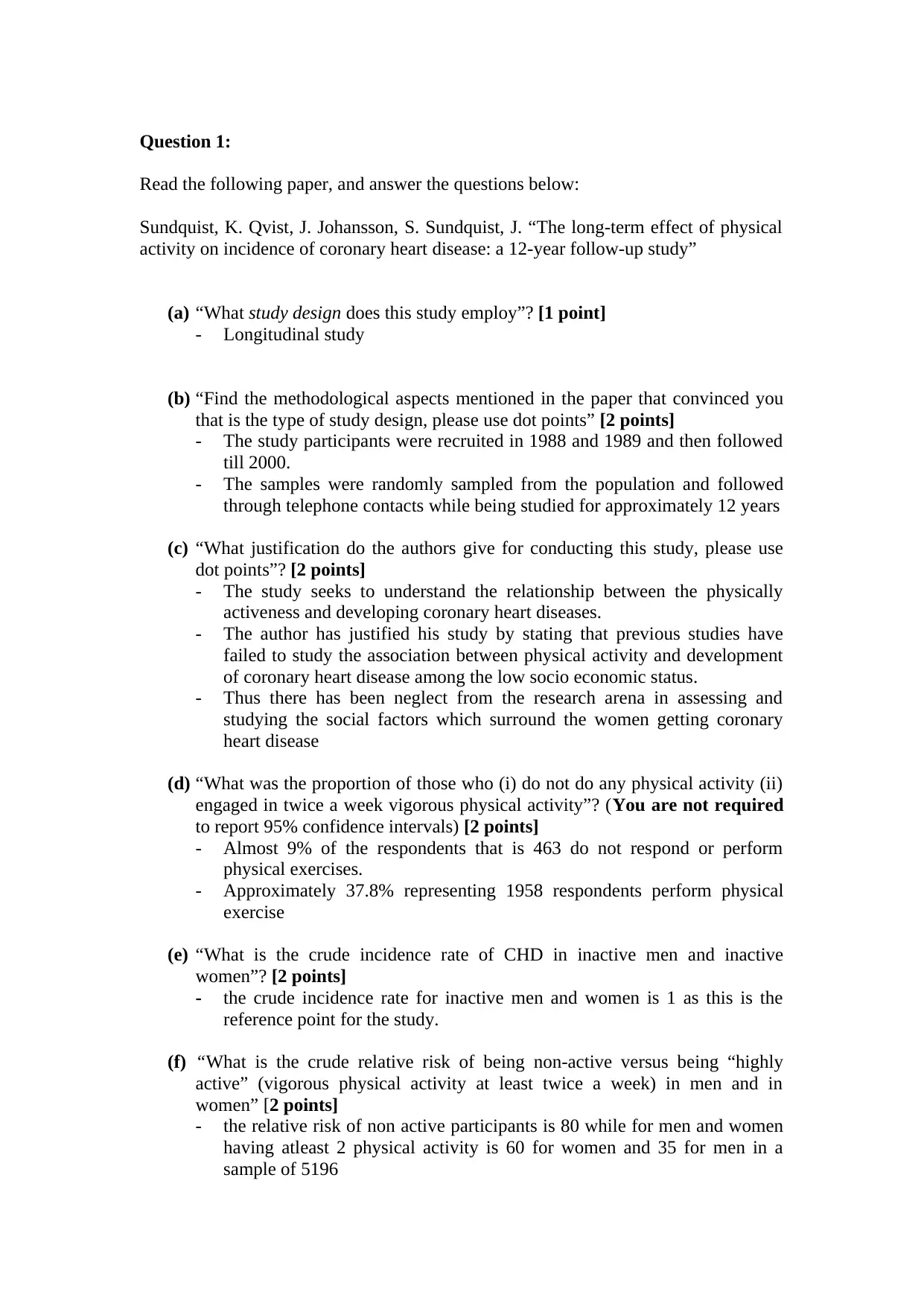
Question 1:
Read the following paper, and answer the questions below:
Sundquist, K. Qvist, J. Johansson, S. Sundquist, J. “The long-term effect of physical
activity on incidence of coronary heart disease: a 12-year follow-up study”
(a) “What study design does this study employ”? [1 point]
- Longitudinal study
(b) “Find the methodological aspects mentioned in the paper that convinced you
that is the type of study design, please use dot points” [2 points]
- The study participants were recruited in 1988 and 1989 and then followed
till 2000.
- The samples were randomly sampled from the population and followed
through telephone contacts while being studied for approximately 12 years
(c) “What justification do the authors give for conducting this study, please use
dot points”? [2 points]
- The study seeks to understand the relationship between the physically
activeness and developing coronary heart diseases.
- The author has justified his study by stating that previous studies have
failed to study the association between physical activity and development
of coronary heart disease among the low socio economic status.
- Thus there has been neglect from the research arena in assessing and
studying the social factors which surround the women getting coronary
heart disease
(d) “What was the proportion of those who (i) do not do any physical activity (ii)
engaged in twice a week vigorous physical activity”? (You are not required
to report 95% confidence intervals) [2 points]
- Almost 9% of the respondents that is 463 do not respond or perform
physical exercises.
- Approximately 37.8% representing 1958 respondents perform physical
exercise
(e) “What is the crude incidence rate of CHD in inactive men and inactive
women”? [2 points]
- the crude incidence rate for inactive men and women is 1 as this is the
reference point for the study.
(f) “What is the crude relative risk of being non-active versus being “highly
active” (vigorous physical activity at least twice a week) in men and in
women” [2 points]
- the relative risk of non active participants is 80 while for men and women
having atleast 2 physical activity is 60 for women and 35 for men in a
sample of 5196
Read the following paper, and answer the questions below:
Sundquist, K. Qvist, J. Johansson, S. Sundquist, J. “The long-term effect of physical
activity on incidence of coronary heart disease: a 12-year follow-up study”
(a) “What study design does this study employ”? [1 point]
- Longitudinal study
(b) “Find the methodological aspects mentioned in the paper that convinced you
that is the type of study design, please use dot points” [2 points]
- The study participants were recruited in 1988 and 1989 and then followed
till 2000.
- The samples were randomly sampled from the population and followed
through telephone contacts while being studied for approximately 12 years
(c) “What justification do the authors give for conducting this study, please use
dot points”? [2 points]
- The study seeks to understand the relationship between the physically
activeness and developing coronary heart diseases.
- The author has justified his study by stating that previous studies have
failed to study the association between physical activity and development
of coronary heart disease among the low socio economic status.
- Thus there has been neglect from the research arena in assessing and
studying the social factors which surround the women getting coronary
heart disease
(d) “What was the proportion of those who (i) do not do any physical activity (ii)
engaged in twice a week vigorous physical activity”? (You are not required
to report 95% confidence intervals) [2 points]
- Almost 9% of the respondents that is 463 do not respond or perform
physical exercises.
- Approximately 37.8% representing 1958 respondents perform physical
exercise
(e) “What is the crude incidence rate of CHD in inactive men and inactive
women”? [2 points]
- the crude incidence rate for inactive men and women is 1 as this is the
reference point for the study.
(f) “What is the crude relative risk of being non-active versus being “highly
active” (vigorous physical activity at least twice a week) in men and in
women” [2 points]
- the relative risk of non active participants is 80 while for men and women
having atleast 2 physical activity is 60 for women and 35 for men in a
sample of 5196
⊘ This is a preview!⊘
Do you want full access?
Subscribe today to unlock all pages.

Trusted by 1+ million students worldwide
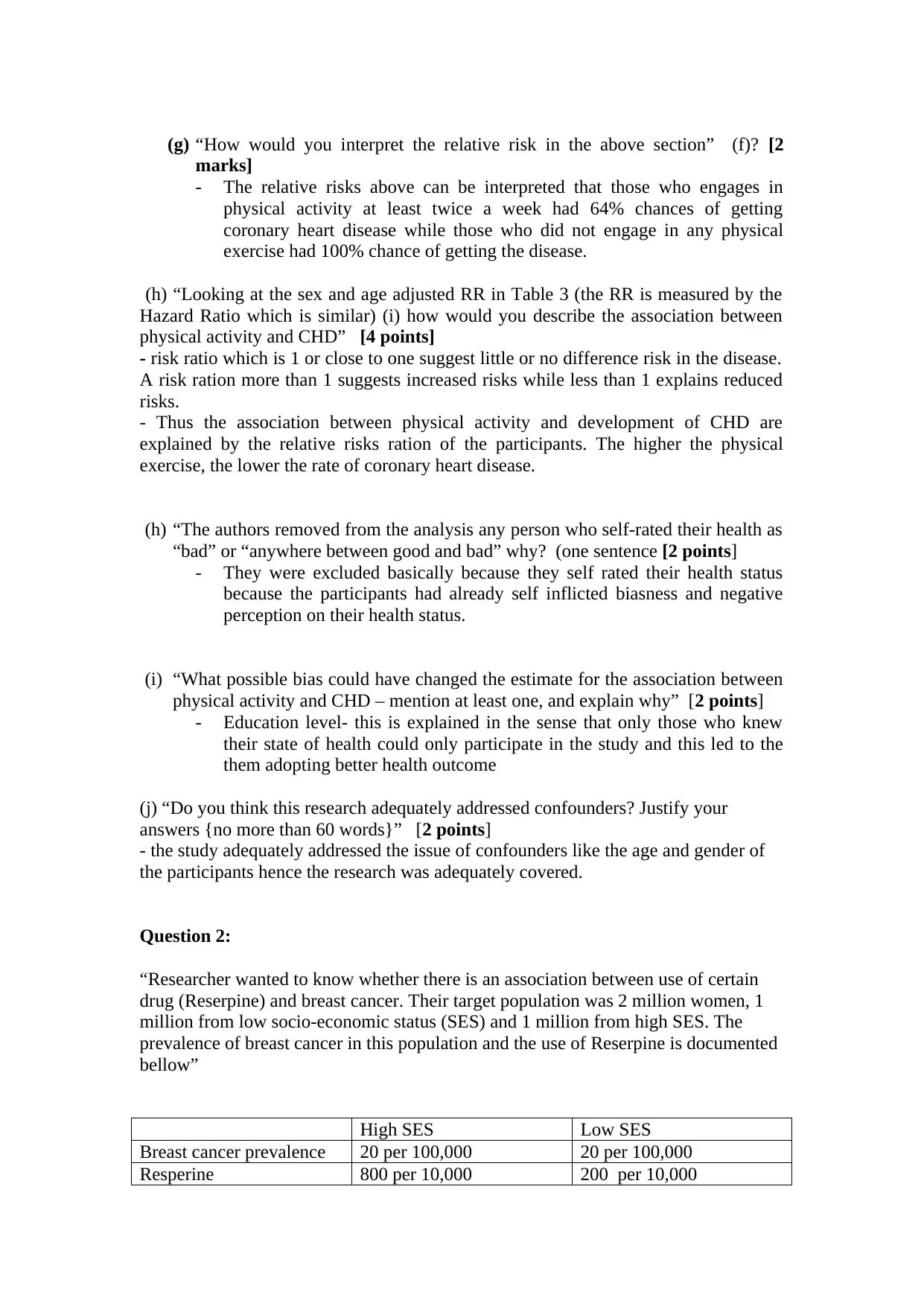
(g) “How would you interpret the relative risk in the above section” (f)? [2
marks]
- The relative risks above can be interpreted that those who engages in
physical activity at least twice a week had 64% chances of getting
coronary heart disease while those who did not engage in any physical
exercise had 100% chance of getting the disease.
(h) “Looking at the sex and age adjusted RR in Table 3 (the RR is measured by the
Hazard Ratio which is similar) (i) how would you describe the association between
physical activity and CHD” [4 points]
- risk ratio which is 1 or close to one suggest little or no difference risk in the disease.
A risk ration more than 1 suggests increased risks while less than 1 explains reduced
risks.
- Thus the association between physical activity and development of CHD are
explained by the relative risks ration of the participants. The higher the physical
exercise, the lower the rate of coronary heart disease.
(h) “The authors removed from the analysis any person who self-rated their health as
“bad” or “anywhere between good and bad” why? (one sentence [2 points]
- They were excluded basically because they self rated their health status
because the participants had already self inflicted biasness and negative
perception on their health status.
(i) “What possible bias could have changed the estimate for the association between
physical activity and CHD – mention at least one, and explain why” [2 points]
- Education level- this is explained in the sense that only those who knew
their state of health could only participate in the study and this led to the
them adopting better health outcome
(j) “Do you think this research adequately addressed confounders? Justify your
answers {no more than 60 words}” [2 points]
- the study adequately addressed the issue of confounders like the age and gender of
the participants hence the research was adequately covered.
Question 2:
“Researcher wanted to know whether there is an association between use of certain
drug (Reserpine) and breast cancer. Their target population was 2 million women, 1
million from low socio-economic status (SES) and 1 million from high SES. The
prevalence of breast cancer in this population and the use of Reserpine is documented
bellow”
High SES Low SES
Breast cancer prevalence 20 per 100,000 20 per 100,000
Resperine 800 per 10,000 200 per 10,000
marks]
- The relative risks above can be interpreted that those who engages in
physical activity at least twice a week had 64% chances of getting
coronary heart disease while those who did not engage in any physical
exercise had 100% chance of getting the disease.
(h) “Looking at the sex and age adjusted RR in Table 3 (the RR is measured by the
Hazard Ratio which is similar) (i) how would you describe the association between
physical activity and CHD” [4 points]
- risk ratio which is 1 or close to one suggest little or no difference risk in the disease.
A risk ration more than 1 suggests increased risks while less than 1 explains reduced
risks.
- Thus the association between physical activity and development of CHD are
explained by the relative risks ration of the participants. The higher the physical
exercise, the lower the rate of coronary heart disease.
(h) “The authors removed from the analysis any person who self-rated their health as
“bad” or “anywhere between good and bad” why? (one sentence [2 points]
- They were excluded basically because they self rated their health status
because the participants had already self inflicted biasness and negative
perception on their health status.
(i) “What possible bias could have changed the estimate for the association between
physical activity and CHD – mention at least one, and explain why” [2 points]
- Education level- this is explained in the sense that only those who knew
their state of health could only participate in the study and this led to the
them adopting better health outcome
(j) “Do you think this research adequately addressed confounders? Justify your
answers {no more than 60 words}” [2 points]
- the study adequately addressed the issue of confounders like the age and gender of
the participants hence the research was adequately covered.
Question 2:
“Researcher wanted to know whether there is an association between use of certain
drug (Reserpine) and breast cancer. Their target population was 2 million women, 1
million from low socio-economic status (SES) and 1 million from high SES. The
prevalence of breast cancer in this population and the use of Reserpine is documented
bellow”
High SES Low SES
Breast cancer prevalence 20 per 100,000 20 per 100,000
Resperine 800 per 10,000 200 per 10,000
Paraphrase This Document
Need a fresh take? Get an instant paraphrase of this document with our AI Paraphraser
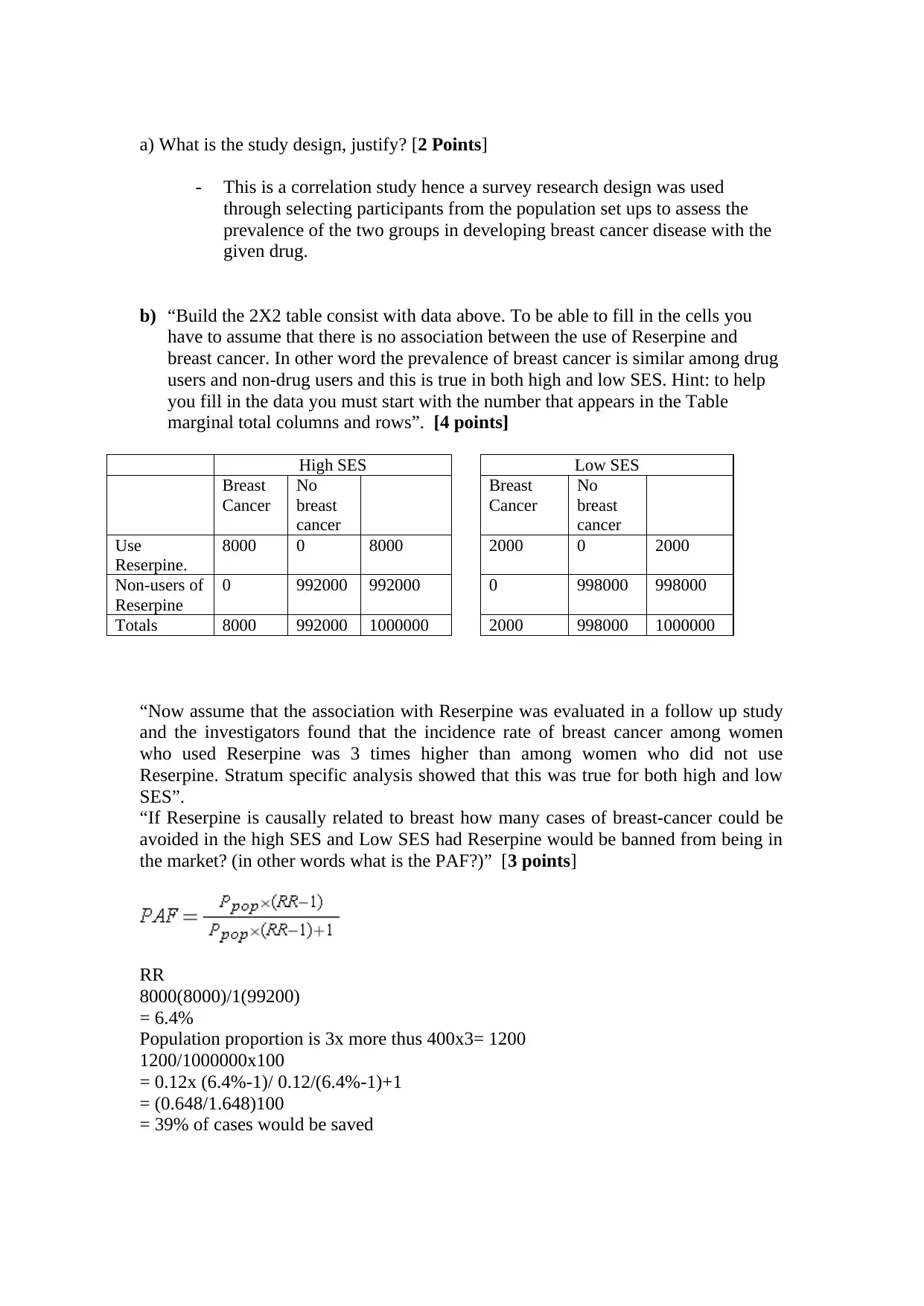
a) What is the study design, justify? [2 Points]
- This is a correlation study hence a survey research design was used
through selecting participants from the population set ups to assess the
prevalence of the two groups in developing breast cancer disease with the
given drug.
b) “Build the 2X2 table consist with data above. To be able to fill in the cells you
have to assume that there is no association between the use of Reserpine and
breast cancer. In other word the prevalence of breast cancer is similar among drug
users and non-drug users and this is true in both high and low SES. Hint: to help
you fill in the data you must start with the number that appears in the Table
marginal total columns and rows”. [4 points]
High SES Low SES
Breast
Cancer
No
breast
cancer
Breast
Cancer
No
breast
cancer
Use
Reserpine.
8000 0 8000 2000 0 2000
Non-users of
Reserpine
0 992000 992000 0 998000 998000
Totals 8000 992000 1000000 2000 998000 1000000
“Now assume that the association with Reserpine was evaluated in a follow up study
and the investigators found that the incidence rate of breast cancer among women
who used Reserpine was 3 times higher than among women who did not use
Reserpine. Stratum specific analysis showed that this was true for both high and low
SES”.
“If Reserpine is causally related to breast how many cases of breast-cancer could be
avoided in the high SES and Low SES had Reserpine would be banned from being in
the market? (in other words what is the PAF?)” [3 points]
RR
8000(8000)/1(99200)
= 6.4%
Population proportion is 3x more thus 400x3= 1200
1200/1000000x100
= 0.12x (6.4%-1)/ 0.12/(6.4%-1)+1
= (0.648/1.648)100
= 39% of cases would be saved
- This is a correlation study hence a survey research design was used
through selecting participants from the population set ups to assess the
prevalence of the two groups in developing breast cancer disease with the
given drug.
b) “Build the 2X2 table consist with data above. To be able to fill in the cells you
have to assume that there is no association between the use of Reserpine and
breast cancer. In other word the prevalence of breast cancer is similar among drug
users and non-drug users and this is true in both high and low SES. Hint: to help
you fill in the data you must start with the number that appears in the Table
marginal total columns and rows”. [4 points]
High SES Low SES
Breast
Cancer
No
breast
cancer
Breast
Cancer
No
breast
cancer
Use
Reserpine.
8000 0 8000 2000 0 2000
Non-users of
Reserpine
0 992000 992000 0 998000 998000
Totals 8000 992000 1000000 2000 998000 1000000
“Now assume that the association with Reserpine was evaluated in a follow up study
and the investigators found that the incidence rate of breast cancer among women
who used Reserpine was 3 times higher than among women who did not use
Reserpine. Stratum specific analysis showed that this was true for both high and low
SES”.
“If Reserpine is causally related to breast how many cases of breast-cancer could be
avoided in the high SES and Low SES had Reserpine would be banned from being in
the market? (in other words what is the PAF?)” [3 points]
RR
8000(8000)/1(99200)
= 6.4%
Population proportion is 3x more thus 400x3= 1200
1200/1000000x100
= 0.12x (6.4%-1)/ 0.12/(6.4%-1)+1
= (0.648/1.648)100
= 39% of cases would be saved
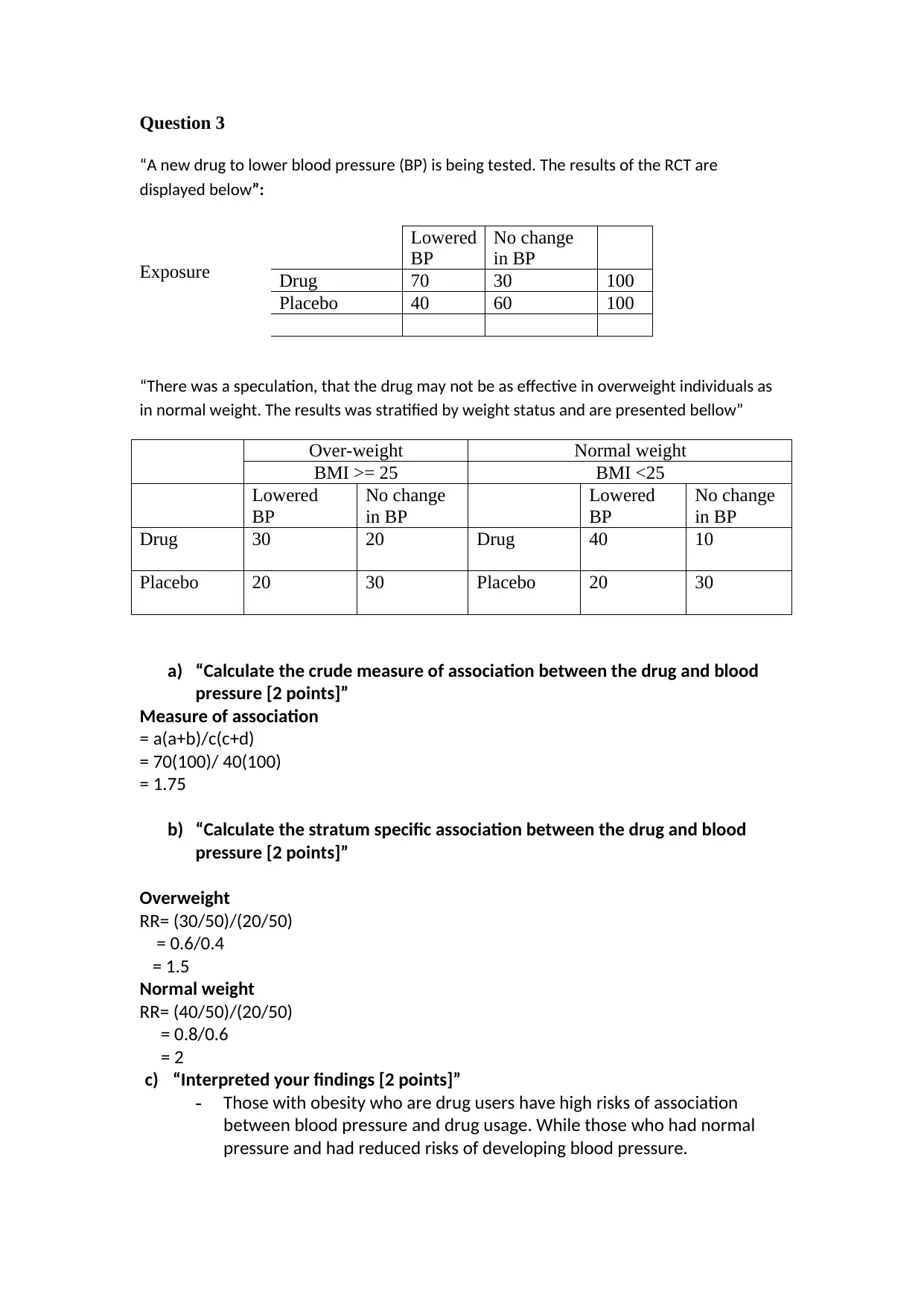
Question 3
“A new drug to lower blood pressure (BP) is being tested. The results of the RCT are
displayed below”:
Exposure
“There was a speculation, that the drug may not be as effective in overweight individuals as
in normal weight. The results was stratified by weight status and are presented bellow”
Over-weight Normal weight
BMI >= 25 BMI <25
Lowered
BP
No change
in BP
Lowered
BP
No change
in BP
Drug 30 20 Drug 40 10
Placebo 20 30 Placebo 20 30
a) “Calculate the crude measure of association between the drug and blood
pressure [2 points]”
Measure of association
= a(a+b)/c(c+d)
= 70(100)/ 40(100)
= 1.75
b) “Calculate the stratum specific association between the drug and blood
pressure [2 points]”
Overweight
RR= (30/50)/(20/50)
= 0.6/0.4
= 1.5
Normal weight
RR= (40/50)/(20/50)
= 0.8/0.6
= 2
c) “Interpreted your findings [2 points]”
- Those with obesity who are drug users have high risks of association
between blood pressure and drug usage. While those who had normal
pressure and had reduced risks of developing blood pressure.
Lowered
BP
No change
in BP
Drug 70 30 100
Placebo 40 60 100
“A new drug to lower blood pressure (BP) is being tested. The results of the RCT are
displayed below”:
Exposure
“There was a speculation, that the drug may not be as effective in overweight individuals as
in normal weight. The results was stratified by weight status and are presented bellow”
Over-weight Normal weight
BMI >= 25 BMI <25
Lowered
BP
No change
in BP
Lowered
BP
No change
in BP
Drug 30 20 Drug 40 10
Placebo 20 30 Placebo 20 30
a) “Calculate the crude measure of association between the drug and blood
pressure [2 points]”
Measure of association
= a(a+b)/c(c+d)
= 70(100)/ 40(100)
= 1.75
b) “Calculate the stratum specific association between the drug and blood
pressure [2 points]”
Overweight
RR= (30/50)/(20/50)
= 0.6/0.4
= 1.5
Normal weight
RR= (40/50)/(20/50)
= 0.8/0.6
= 2
c) “Interpreted your findings [2 points]”
- Those with obesity who are drug users have high risks of association
between blood pressure and drug usage. While those who had normal
pressure and had reduced risks of developing blood pressure.
Lowered
BP
No change
in BP
Drug 70 30 100
Placebo 40 60 100
⊘ This is a preview!⊘
Do you want full access?
Subscribe today to unlock all pages.

Trusted by 1+ million students worldwide
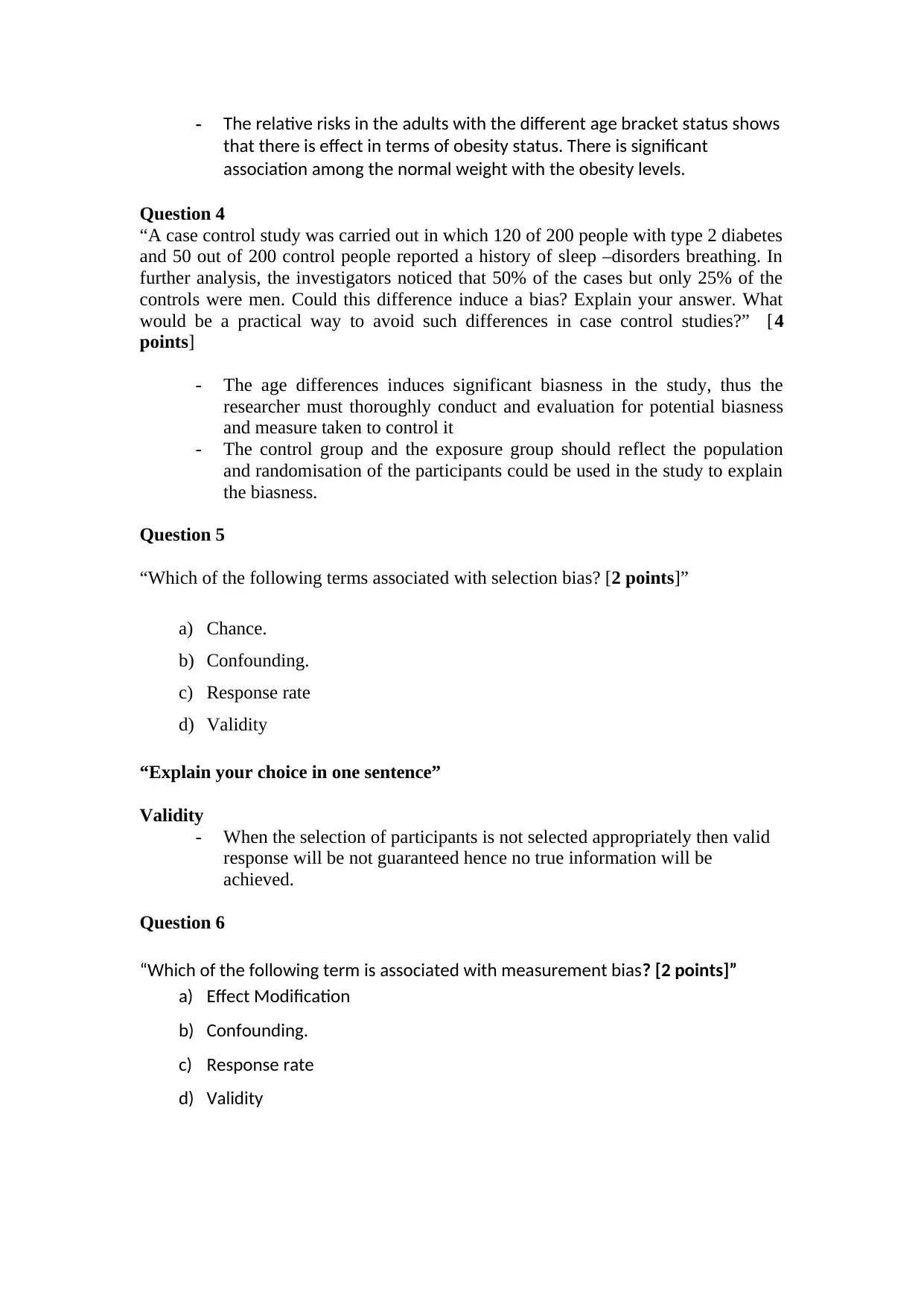
- The relative risks in the adults with the different age bracket status shows
that there is effect in terms of obesity status. There is significant
association among the normal weight with the obesity levels.
Question 4
“A case control study was carried out in which 120 of 200 people with type 2 diabetes
and 50 out of 200 control people reported a history of sleep –disorders breathing. In
further analysis, the investigators noticed that 50% of the cases but only 25% of the
controls were men. Could this difference induce a bias? Explain your answer. What
would be a practical way to avoid such differences in case control studies?” [4
points]
- The age differences induces significant biasness in the study, thus the
researcher must thoroughly conduct and evaluation for potential biasness
and measure taken to control it
- The control group and the exposure group should reflect the population
and randomisation of the participants could be used in the study to explain
the biasness.
Question 5
“Which of the following terms associated with selection bias? [2 points]”
a) Chance.
b) Confounding.
c) Response rate
d) Validity
“Explain your choice in one sentence”
Validity
- When the selection of participants is not selected appropriately then valid
response will be not guaranteed hence no true information will be
achieved.
Question 6
“Which of the following term is associated with measurement bias? [2 points]”
a) Effect Modification
b) Confounding.
c) Response rate
d) Validity
that there is effect in terms of obesity status. There is significant
association among the normal weight with the obesity levels.
Question 4
“A case control study was carried out in which 120 of 200 people with type 2 diabetes
and 50 out of 200 control people reported a history of sleep –disorders breathing. In
further analysis, the investigators noticed that 50% of the cases but only 25% of the
controls were men. Could this difference induce a bias? Explain your answer. What
would be a practical way to avoid such differences in case control studies?” [4
points]
- The age differences induces significant biasness in the study, thus the
researcher must thoroughly conduct and evaluation for potential biasness
and measure taken to control it
- The control group and the exposure group should reflect the population
and randomisation of the participants could be used in the study to explain
the biasness.
Question 5
“Which of the following terms associated with selection bias? [2 points]”
a) Chance.
b) Confounding.
c) Response rate
d) Validity
“Explain your choice in one sentence”
Validity
- When the selection of participants is not selected appropriately then valid
response will be not guaranteed hence no true information will be
achieved.
Question 6
“Which of the following term is associated with measurement bias? [2 points]”
a) Effect Modification
b) Confounding.
c) Response rate
d) Validity
Paraphrase This Document
Need a fresh take? Get an instant paraphrase of this document with our AI Paraphraser
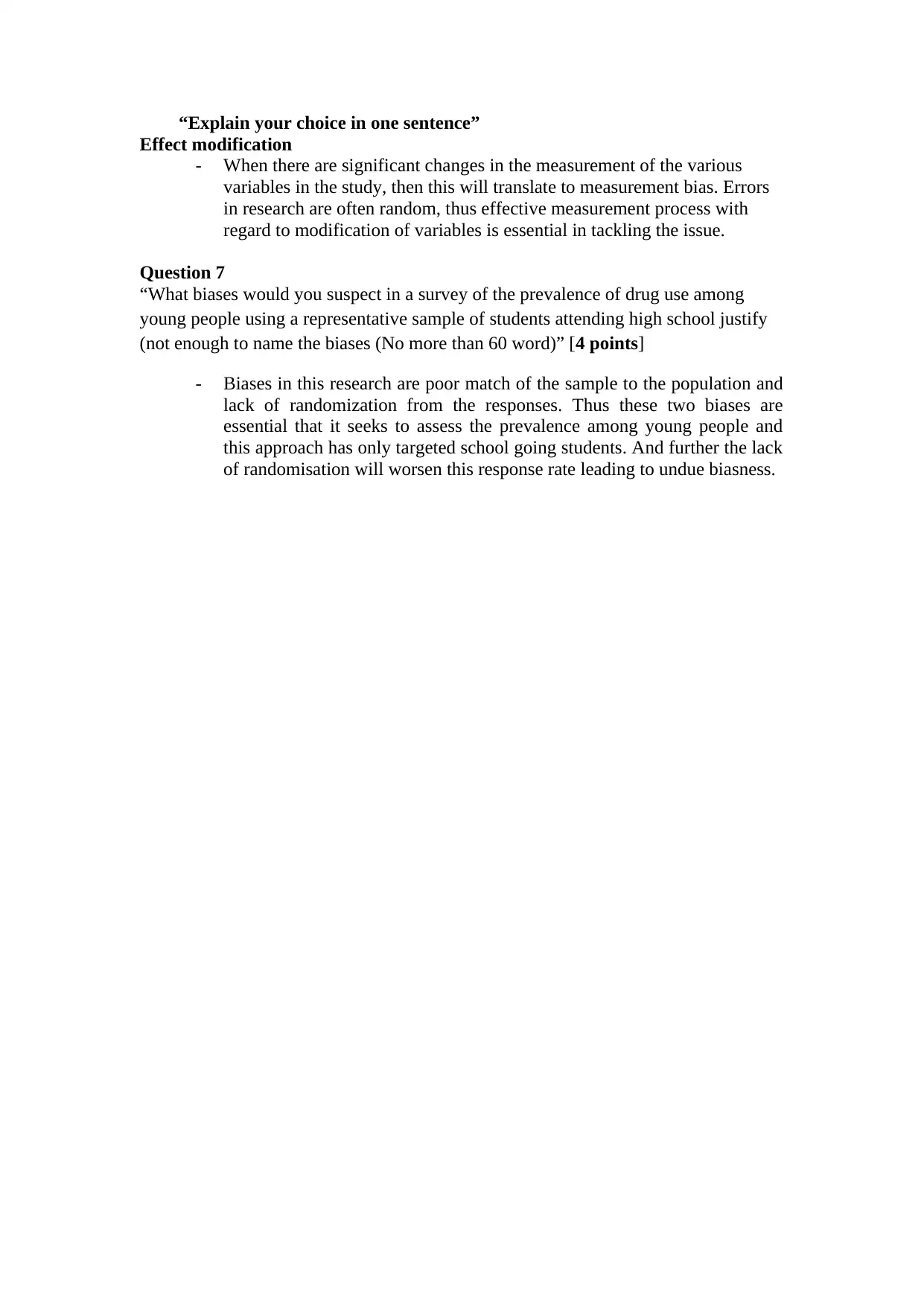
“Explain your choice in one sentence”
Effect modification
- When there are significant changes in the measurement of the various
variables in the study, then this will translate to measurement bias. Errors
in research are often random, thus effective measurement process with
regard to modification of variables is essential in tackling the issue.
Question 7
“What biases would you suspect in a survey of the prevalence of drug use among
young people using a representative sample of students attending high school justify
(not enough to name the biases (No more than 60 word)” [4 points]
- Biases in this research are poor match of the sample to the population and
lack of randomization from the responses. Thus these two biases are
essential that it seeks to assess the prevalence among young people and
this approach has only targeted school going students. And further the lack
of randomisation will worsen this response rate leading to undue biasness.
Effect modification
- When there are significant changes in the measurement of the various
variables in the study, then this will translate to measurement bias. Errors
in research are often random, thus effective measurement process with
regard to modification of variables is essential in tackling the issue.
Question 7
“What biases would you suspect in a survey of the prevalence of drug use among
young people using a representative sample of students attending high school justify
(not enough to name the biases (No more than 60 word)” [4 points]
- Biases in this research are poor match of the sample to the population and
lack of randomization from the responses. Thus these two biases are
essential that it seeks to assess the prevalence among young people and
this approach has only targeted school going students. And further the lack
of randomisation will worsen this response rate leading to undue biasness.
1 out of 8
Related Documents
Your All-in-One AI-Powered Toolkit for Academic Success.
+13062052269
info@desklib.com
Available 24*7 on WhatsApp / Email
![[object Object]](/_next/static/media/star-bottom.7253800d.svg)
Unlock your academic potential
Copyright © 2020–2025 A2Z Services. All Rights Reserved. Developed and managed by ZUCOL.





